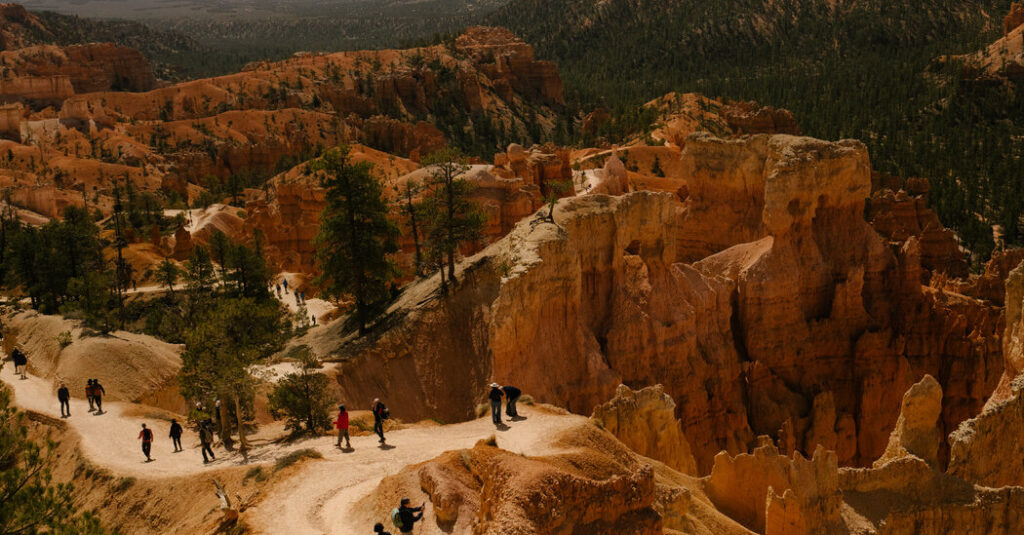Today is something of a curtain raiser for the U.S. National Parks system, ushering in its busiest season.
Last year, nearly 312 million people visited the parks, hiking across the Grand Canyon, posting Instagram stories from Joshua Tree and waiting for Old Faithful by Yellowstone’s rainbow pools. (Reminder: Don’t touch the bison calves!) On Memorial Day last year, so many people headed to the sites that many of their parking lots were full by midmorning.
At Bryce Canyon National Park in Utah, home to 50-million-year-old rock formations, park rangers start clearing the way for visitors weeks ahead of the busy season. They restore dozens of miles of trails — removing debris and navigating steep cliffs on foot before the snow even melts, as my colleague Linda Qiu reported in a story with photos by Erin Schaff. Similar preparation plays out at the system’s parks around the country.
Cleaning up erosion
Over millions of years, wind and rain have shaped the limestone in Bryce Canyon into maze of spire-shaped rocks shooting into the air at 8,000 feet. The process is responsible for the park’s dramatic beauty. But it’s also a pain for rangers.
Each winter, the rain and snow sand down the rock faces and degrade trails. Each spring, crews clear hiking paths of debris, mostly by hand to limit destruction to the natural habitat.
“The amount of physical labor used to clear the trails was so surprising to me,” Erin said. “The rocks they lift are incredibly heavy. Like, how can you repetitively do this all summer to your back?”
Unusually intense storms and a wet winter this past year wrought severe damage, delaying trail openings and complicating cleanup. One side of the trail remains closed as crews continue repairs, digging out the surface of the route and installing wire baskets filled with large rocks along the perimeter to divert water and facilitate drainage.
Training for emergencies
The rock slides and high elevation pose a risk for visitors, too.
Bryce averages around 40 search-and-rescue operations a year, often to help people who have fallen. Rangers and local volunteers undergo basic technical rescue training, learning to use ropes and high-angle equipment for more complicated rescues.
Here’s one example: Last summer, a visitor could not complete a strenuous eight-mile hike. She tried to take a shortcut to return to the starting point and became separated from her grandchildren. Hours later, rangers found her clinging to a precipitous slope, unable to move. Securing ropes, they descended and lifted her to safety.
Ensuring dark skies
The rangers have to fit all of their cleanup and prep work into daylight hours. At night, their job is to keep the lights off, protecting Bryce’s status as a dark-sky park: After sunset, less than 1 percent of Bryce Canyon is lit by artificial light.
“It’s clear how proud they are of the uniqueness of Bryce’s night sky,” Linda said. “They’re conserving the park, but they’re also preserving a view of the Milky Way.”
Read Linda’s story and see more of Erin’s photos from Bryce Canyon here.
THE LATEST NEWS
Turkish Election
Politics
Other Big Stories
Opinions
This Memorial Day weekend, Kayla M. Williams remembers the civilians and service members who died outside combat.
Goodbye to ‘Succession’
HBO’s “Succession,” which aired its finale last night, was in many ways the late-capitalist heir to “Dallas,” the Times TV critic James Poniewozik wrote, a prime-time saga that used delicious dialogue and sibling rivalries to explore the nature of wealth. What made the shows different, though, was the ways that wealth has changed since the 1980s — namely, the rich are now much richer. “The holdings of Waystar Royco,” James writes, “make Ewing Oil look like a franchise gas station.”
More on “Succession”:


